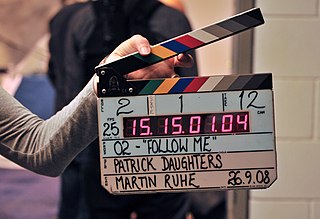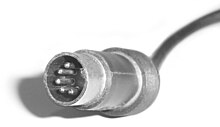Linear Timecode (LTC) is an encoding of SMPTE timecode data in an audio signal, as defined in SMPTE 12M specification. The audio signal is commonly recorded on a VTR track or other storage media. The bits are encoded using the biphase mark code : a 0 bit has a single transition at the start of the bit period. A 1 bit has two transitions, at the beginning and middle of the period. This encoding is self-clocking. Each frame is terminated by a 'sync word' which has a special predefined sync relationship with any video or film content.

MIDI is a technical standard that describes a communications protocol, digital interface, and electrical connectors that connect a wide variety of electronic musical instruments, computers, and related audio devices for playing, editing, and recording music. The specification originates in the paper Universal Synthesizer Interface published by Dave Smith and Chet Wood of Sequential Circuits at the 1981 Audio Engineering Society conference in New York City.
MIDI time code (MTC) embeds the same timing information as standard SMPTE timecode as a series of small 'quarter-frame' MIDI messages. There is no provision for the user bits in the standard MIDI time code messages, and SysEx messages are used to carry this information instead. The quarter-frame messages are transmitted in a sequence of eight messages, thus a complete timecode value is specified every two frames. If the MIDI data stream is running close to capacity, the MTC data may arrive a little behind schedule which has the effect of introducing a small amount of jitter. In order to avoid this it is ideal to use a completely separate MIDI port for MTC data. Larger full-frame messages, which encapsulate a frame worth of timecode in a single message, are used to locate to a time while timecode is not running.

Digital Visual Interface (DVI) is a video display interface developed by the Digital Display Working Group (DDWG). The digital interface is used to connect a video source, such as a video display controller, to a display device, such as a computer monitor. It was developed with the intention of creating an industry standard for the transfer of uncompressed digital video content.

Composite video is an analog video signal format that carries standard-definition video as a single channel. Video information is encoded on one channel, unlike the higher-quality S-Video and the even higher-quality component video. In all of these video formats, audio is carried on a separate connection.

SMPTE timecode is a set of cooperating standards to label individual frames of video or film with a timecode. The system is defined by the Society of Motion Picture and Television Engineers in the SMPTE 12M specification. SMPTE revised the standard in 2008, turning it into a two-part document: SMPTE 12M-1 and SMPTE 12M-2, including new explanations and clarifications.

Modular synthesizers are synthesizers composed of separate modules for different functions. The modules can be connected together by the user to create a patch. The outputs from the modules may include audio signals, analog control voltages, or digital signals for logic or timing conditions. Typical modules are voltage-controlled oscillators, voltage-controlled filters, voltage-controlled amplifiers and envelope generators.

Component video is an analog video signal that has been split into two or more component channels. In popular use, it refers to a type of component analog video (CAV) information that is transmitted or stored as three separate signals. Component video can be contrasted with composite video in which all the video information is combined into a single signal that is used in analog television. Unlike composite, component cables do not carry audio and are often paired with audio cables.

CV/gate is an analog method of controlling synthesizers, drum machines, and similar equipment with external sequencers. The control voltage typically controls pitch and the gate signal controls note on-off.
The Serial Peripheral Interface (SPI) is a synchronous serial communication interface specification used for short-distance communication, primarily in embedded systems. The interface was developed by Motorola in the mid-1980s and has become a de facto standard. Typical applications include Secure Digital cards and liquid crystal displays.

The Roland TR-909 Rhythm Composer is a drum machine introduced by Roland Corporation in 1983, succeeding the TR-808. It was the first Roland drum machine to use samples for some sounds, and the first with MIDI functionality, allowing it to synchronize with other devices. Though it was a commercial failure, the 909 became influential in the development of electronic dance music genres such as techno, house and acid.

The Television Interface Adaptor (TIA) is the custom computer chip, along with a variant of the MOS Technology 6502 constituting the heart of the 1977 Atari Video Computer System game console. The TIA generates the screen display, sound effects, and reads the controllers. At the time the Atari VCS was designed, even small amounts of RAM were expensive. The chip was designed around not having a frame buffer, instead requiring detailed programming to create even a simple display.
The Yamaha AN1x is a DSP-based analog modeling synthesizer, produced by Yamaha Corporation from 1997 to 1998, and was marketed as an "analog physical modelling control synthesizer".
I²S, is an electrical serial bus interface standard used for connecting digital audio devices together. It is used to communicate PCM audio data between integrated circuits in an electronic device. The I²S bus separates clock and serial data signals, resulting in simpler receivers than those required for asynchronous communications systems that need to recover the clock from the data stream. Alternatively I²S is spelled I2S or IIS. Despite the similar name, I²S is unrelated to the bidirectional I²C (IIC) bus.

The Roland MC-202 (MicroComposer) is a monophonic analog synthesizer and music sequencer released by Roland in 1983. It was the first groovebox. Its synth is similar to the TB-303 bass synth and the SH-101 synthesizer, featuring one voltage-controlled oscillator with simultaneous saw and square/pulse-width waveforms. It is a successor to the Microcomposer family of sequencers, including the MC-8 and MC-4. The unit is portable and can be operated from batteries or an external power supply.
The Memorymoog is a polyphonic electronic music synthesizer manufactured by Moog Music from 1982 to 1985, the last polyphonic synthesizer to be released by Moog Music before the company declared bankruptcy in 1987. While comparable to other polyphonic synthesizers of the time period, such as the Sequential Circuits Prophet-5 and Oberheim OB-Xa, the Memorymoog distinguished itself with 3 audio oscillators per voice and greater preset storage capacity.
The Doctor Rhythm DR-110 Graphic is a drum machine introduced in 1983 by the Boss product division of the Japanese Roland Corporation. It was the second entry in their DR series, following up on the much simpler DR-55.
The ADAT Lightpipe, officially the ADAT Optical Interface, is a standard for the transfer of digital audio between equipment. It was originally developed by Alesis but has since become widely accepted, with many third party hardware manufacturers including Lightpipe interfaces on their equipment. The protocol has become so popular that the term ADAT is now often used to refer to the transfer standard rather than to the Alesis Digital Audio Tape itself.
MIDI beat clock, or simply MIDI clock, is a clock signal that is broadcast via MIDI to ensure that several MIDI-enabled devices such as a synthesizer or music sequencer stay in synchronization. Clock events are sent at a rate of 24 pulses per quarter note. Those pulses are used to maintain a synchronized tempo for synthesizers that have BPM-dependent voices and also for arpeggiator synchronization.

The AX60 is a polyphonic analogue keyboard synthesizer manufactured by Akai Professional in the mid-1980s. It was Akai's answer to the popular Roland Juno series synthesizers. The AX60 uses voltage-controlled analogue oscillators and filter circuitry based on the Curtis Electronics CEM 3394 integrated circuit.












